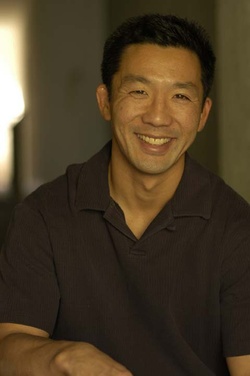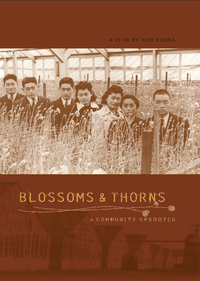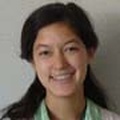The phrase “Richmond, California, 1942” might call to mind the patriotic bustle of naval shipyards and the stoic biceps of Rosie the Riveter, but this would obscure another story: that of the Japanese American residents who were forcibly removed from their homes and businesses in this coastal town and sent to concentration camps for the duration of the war. The documentary film Blossoms and Thorns: A Community Uprooted (Kokka 2012) reveals the contradictions between these two experiences of wartime Richmond by bringing Japanese Americans into the frame to tell their stories. With help from archival images and contextual comments from historian Donna Graves, the interviewees provide both an effective overview of Japanese American history and a personal, emotional record of this specific community and the cut-flower industry.
In January 2013, filmmaker Kenneth Kokka kindly agreed to answer a few questions via email regarding the making of the film and the Japanese American nursery community. As told to Fiona Potter.
Fiona Potter (FP): What inspired you to want to tell this story?
Kenneth Kokka (KK): I originally became aware of the Richmond Japanese American flower growing community while doing research for a film adaptation of a Toshio Mori short story, “The Chessmen.” I changed the time period of the story from pre-war to post-internment to focus on the challenges that faced my parents and grandparents during the resettlement period after WWII. After extensive research, I ended up shooting the film at the Oishi and Sakai nurseries in Richmond, which by 2002 were among the last Japanese American owned nurseries still in operation in California.
I was extremely fortunate to find the Oishi and Sakai families. They helped me immeasurably, both with technical consultation and physical labor. I am particularly indebted to Bill Sakai and Larry Oishi. As it turns out, the Oishi and Sakai families are related to Toshio Mori by marriage. At a family reunion a few years ago, I met some of Mori’s descendants, who happened to know my own parents from their days at Cal. (The East Bay JA community is smaller than I had realized!)
After the Oishi and Sakai nurseries were sold for redevelopment in the mid-2000s and tabbed for demolition, there was an upsurge in interest in capturing their history and commemorating their importance to the El Cerrito/Richmond region. The Contra Costa JACL conducted a search for a filmmaker, and I was fortunate enough to be selected.
I feel that the story of the JA-owned nurseries deserves to be told, as it represents a tale of quintessential American immigrant success—and a cautionary story with regard to racial prejudice in this country. It’s also a poignant story insomuch as the business is dying out now, due to a variety of factors. My goal was to capture a sense of the promise that the nurseries once held, and their importance to a way of life that might be forgotten if not documented.
FP: How did you find your interview subjects? Do all of them still live in the Richmond/East Bay area?
KK: We located our interview subjects through the Contra Costa JACL video committee, which was formed specifically for the production of this project. The three primary interview subjects, Tom Oishi, Flora Ninomiya, and Ruby Adachi Hiramoto, still reside in the Richmond/El Cerrito region. Flora still has a small nursery, and Ruby still works part-time at her family’s flower shop. Tom is officially retired.
FP: How long did it take to make the film?
KK: All told, about three years. I was originally selected in 2009 for the project, but we didn’t start interviewing subjects until 2010/2011 due to my work schedule. We posted the film in early 2012 and held the public premiere at the Rosie the Riveter World War II Home Front Visitors Center in Richmond, where the video is part of their permanent collection and plays weekly, with a docent to facilitate discussion after each screening.
FP: What is the current status of the nurseries?
KK: The Oishi and Sakai nurseries were sold for redevelopment in the mid-2000s. For over five years they sat idle, and the greenhouses fell into disrepair. Vandals broke the window panes and tagged buildings. The greenhouses were choked with weeds—and stubborn flowers. Eventually the developer had to set up a guard station to keep folks off the property. During that time, preservationists negotiated with the developers and local community to save some physical remnants of the nursery life. By 2010, many of the greenhouses had already fallen or were mere skeletons of their former selves, when the Miraflores development finally broke ground. I believe the current plan is to restore and maintain one of the original nursery owner’s houses, along with a water tower and a greenhouse.

A still from the film "Blossoms and Thorns" shows the persistence of flowers in an abandoned nursery greenhouse
FP: What have you learned from this project?
KK: I guess the greatest lesson I learned is to capture the voices and faces and stories of our older generations while we still have the chance. I have an uncle who served in the 442, and I regret that I didn’t press him for more stories of his service in WWII. Nisei in particular tend to be modest and self-effacing, so it takes a bit more effort to draw them out, but it’s worth the time to preserve their voices.
FP: What is the most important thing that you hope viewers will take away from your documentary?
KK: I hope that viewers will walk away with a sense of what it might have felt like to have experienced internment themselves. I was particularly taken by Tom Oishi’s story, in part because I have a hard time imagining how I might have reacted as a young, vibrant American man in my twenties to a forced, unjust relocation. In a way, I feel that the video captures his loss of innocence, which to me represents a generation’s loss of innocence. Prior to the war, Tom thought of himself as good as the next white man. But after his internment and a subsequent stint in the military, he felt quite differently.
FP: Do you have any plans for future projects?
KK: I’d like to explore the conflict between the 442nd volunteers and the No-No boys. I’m not sure what form this should take just yet, and the territory is familiar to most JA audiences by now, but I feel like it’s deep, rich material that Americans as a whole know little to nothing about.
FP: Any final thoughts about this filmmaking experience that you would like to share?
KK: I grew up with some awareness of internment. When my parents met others from their generation, they almost always asked, “What camp were you in?” I grew up in my own bubble in Berkeley, believing that most people had at least some passing knowledge of the wartime incarceration of Japanese Americans. Now that we’re screening the documentary in non-JA-related venues, I’m discovering that many audiences have little-to-no familiarity with this history. This is stunning but not surprising, really; shameful governmental decisions have a way of being swept under the rug. If we don’t speak up and speak out about these experiences, they may well be neglected and eventually forgotten by the public as a whole.
* In addition to weekly screenings at the Rosie the Riveter Homefront Visitor Center in Richmond, California, Blossoms and Thorns will have several additional screenings in early 2013. If you are interested in viewing the film or screening it for a group, please contact the Contra Costa Japanese American Citizens League at contracostajacl@gmai.com.
To read a brief review of the film on Discover Nikkei >>
* * *
Film Screenings
Blossoms and Thorns: A Community Uprooted by Kenneth Kokka
Saturday, February 2, 2013 • 2PM
Japanese American National Museum
Los Angeles, California
The film is also available for purchase through the JANM online store >>
© 2013 Japanese American National Museum






